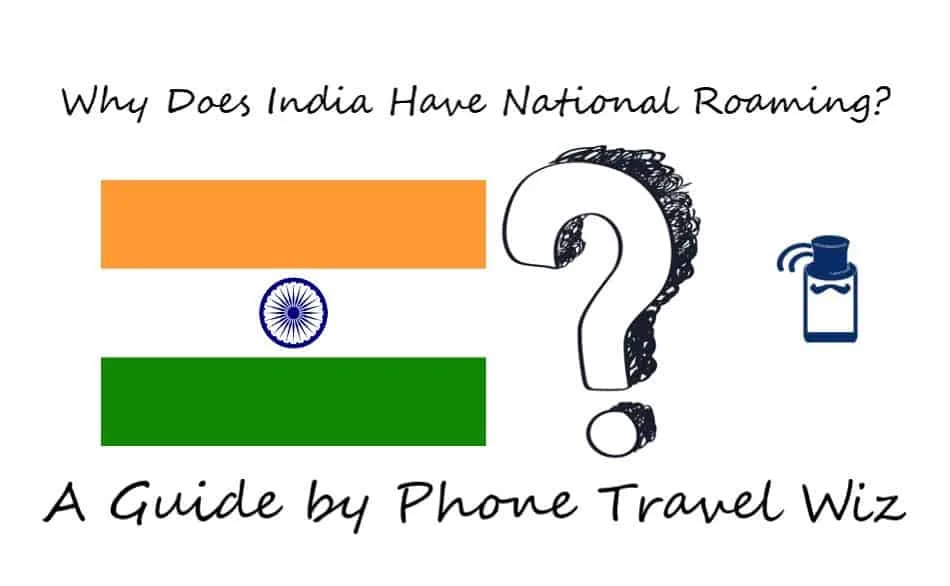National roaming in India makes things a bit confusing for the consumer. In what telecom circle is the person you want to call, what are the long-distance rates for each telecom circle, and what are the roaming rates if you are in a different state. Many countries do not have national roaming, so what makes India special? I wanted to find out.
Why does India have national roaming? India has national roaming with the intention to keep phone charges low by only charging those who want to make long-distance calls or use their phones while in another state. As a result, overall phone-usage prices can be kept low.
Also, operators can keep costs low by not being required to have telecom infrastructure all over the country while offering nation-wide service, which translates to lower prices for the consumer. But there is more to it.
No idea how roaming works? I made this comprehensive guide about what roaming is and how it works. It is worth the read – promised!

What is national roaming and how does national work in India?
National roaming is when a user can move from one mobile operator to another within the same country without requiring the roamer to be a customer of the providing network.
For example, Airtel customers could be roaming on the Idea network where Airtel has no coverage or Jio customers on Airtel's network – only if the providers have national roaming agreements.
A national roaming agreement is when operators want and allow their customers to use each other’s to provide service in areas where they have no or inadequate coverage.
This is done to provide greater service to the customer who does not have to deal with large areas where they cannot get any signals.
National roaming agreements allow operators to provide coverage across a country without having to spend money to build their own infrastructure.
India is divided into 23 telecom circles, which are telecom service areas.
Let’s say provider A has coverage across the country, except for in telecom circle 1. Operator B does cover telecom circle 1 but has no infrastructure in circle 5, both operators can set up a roaming agreement so that their customers can use their phones in circles 1 and 5, which would not have been possible without this agreement.
National roaming agreements are useful and beneficial to the consumer and the operator. For the consumer, they can use their phones in areas that would be considered black-out zones, while operators can claim that they provide nation-wide coverage.
However, this comes at a cost. Telecom providers charge each other wholesale roaming charges (per minute, text, or data in KB, MB, or GB) to use each other’s networks.
Operators can charge each other whatever they want because there are often no frameworks for how much they can charge each other. As a result, national roaming can be expensive.
In addition to these arbitrary rates, which gets passed onto the customer, operators often add a mark-up to the consumer, meaning that the customer could get charges twice: the wholesale roaming rates and the provider mark-up
What are Indian telecom circles (telecom service areas)?
A telecom circle, or officially telecom service area, typically refers to a state or zone where a call is treated as a local call. When the call is destined to reach another zone than where the caller is, the call will be treated as a long-distance call. The same counts for using your phone in another zone than your base circle.
The Department of Telecommunications has divided India into 23 telecom circles, which can be referred to service areas or zones. The borders of the circles roughly correspond to the borders of the states, but there some exceptions.
A few of the smaller states are grouped together with bigger neighboring states, or smaller states get grouped together and become one big state (in regards to telecom circles).
Each telecom circle is categorized into four categories based on subscriber base and revenue potential: Metro, A, B, or C. Areas with the Metro label have the highest revenue potential, while C states and regions have the lowest, based on the population of the area.
What are the telecom circles in India?
In the tables below, you can find all the official telecom circle names, their codes, categories, and the geographical areas covered set by the India Department of Telecommunications – grouped by their labels.
Note that operators can, however, decide to not conform with this usage, and may deviate from it slightly.
India Telecom Circles – Metro Category
| Circle | Code | Area(s) covered |
|---|---|---|
| Delhi | DL | Delhi, Faridabad, Ghaziabad, Gurgaon, and Noida |
| Kolkata | KO | Kolkata* |
| Mumbai | MU | Mumbai, Navi Mumbai, and Kalyan |
* Includes parts of Howrah, Hooghly, North and South 24 Parganas, and Nadia Districts
India Telecom Circles – Category A
| Circle | Code | Area(s) covered |
|---|---|---|
| Andhra Pradesh & Telangana | AP | State of Andhra Pradesh, State of Telangana, and Yanam district |
| Gujarat | GJ | State of Gujarat, Daman and Diu, Dadra, and Nagar Haveli |
| Karnataka | KA | State of Karnataka |
| Maharashtra & Goa | MH | State of Maharashtra*, and State of Goa |
| Tamil Nadu 1 | TN | State of Tamil Nadu, Puducherry district, and Karaikal district |
* Excludes Mumbai, Navi Mumbai, and Kalyan
1 Chennai Metro used to be its separate telecom circle until 2007 when it got merged into the Tamil Nady circle. Although not a circle anymore, you may hear people referring to Chennai as Chennai Metro. Just remember that it is part of Tamil Nadu.
India Telecom Circles – Category B
| Circle | Code | Area(s) covered |
|---|---|---|
| Haryana | HR | State of Haryana* |
| Kerala & Lakshadweep | KL | State of Kerala, Lakshadweep, and Mahé district |
| Madhya Pradesh & Chhattisgarh | MP | State of Madhya Pradesh, and the State of Chhattisgarh |
| Punjab | PB | State of Punjab, Chandigarh, and Panchkula |
| Rajasthan | RJ | State of Rajasthan |
| UP (East) | UE | Eastern Uttar Pradesh |
* Excludes Faridabad, Gurgaon, and Panchkula
India Telecom Circles – Category C
| Circle | Code | Area(s) covered |
|---|---|---|
| Assam | AS | State of Assam |
| Bihar & Jharkhand | BR | State of Bihar and State of Jharkhand |
| Himachal Pradesh | HP | State of Himachal Pradesh |
| Jammu and Kashmir | JK | State of Jammu and Kashmir |
| North East | NE | State of Arunachal Pradesh, State of Meghalaya, State of Mizoram, State of Nagaland, State of Manipur and State of Tripura |
| Odisha | OR | State of Odisha |
| West Bengal | WB | State of West Bengal*, Andaman and Nicobar Islands and the State of Sikkim |
| Ghaziabad & Noida | GB | Ghazibad & Noida Regions |
* Excludes Kolkata
The future of national roaming in India
Although India is a big country, national roaming can be considered to be old-fashioned. Customers in countries bigger than India such as China, Russia, Canada, and the United States do not have to worry about roaming rates within their countries – most operators offer free long-distance calls and texts as well nowadays.
In addition, most of the regional operators have been bought up or merged with bigger operators like Airtel, BSNL, MTNL, Reliance Jio, and Vodafone-Idea, meaning that there is no real need for national roaming.
On Reliance Jio's 42nd annual general meeting for its shareholders, Mukesh Ambani, Reliance Industries Chief and Chairman, announced that the company planned to offer free voice calls with no roaming charges to its customers.
Customers should pay for only one service, voice or data not both. Worldwide operators charge only for data, and voice and messages are free. All voice calls for Jio customer will be absolutely free. The era of paying for voice calls is ending.
Mukesh Ambani, Reliance Industries Chief and Chairman, 1st of September, 2016
On the same day, Jio announced its plan to disrupt the international roaming market with its international roaming packages, which I have analyzed thoroughly.
A few months later, Airtel announced that it would provide free national roaming for all its customers starting from April 2017.
This meant that Airtel customers could finally enjoy free incoming calls & SMS, and no premium would be charged on outgoing calls. Now, Airtel customers can use their phones freely wherever they are in the country, which Airtel marked as the death of national roaming in their press release.
This marks the death of national roaming and the whole country will now be like a local network for our customers, who will not have to think twice before making or receiving calls or using data while traveling outside their home base.
Gopal Vittal, MD & CEO (India & South Asia), Bharti Airtel, February 27, 2017
I believe that the remaining operators will soon follow Airtel and Jio steps to stay competitive. We are three years later after Jio made its roaming announcement and Idea still does not offer free national roaming.
Regardless, I believe that Airtel's death to national roaming statement will become a reality – sooner or later.
